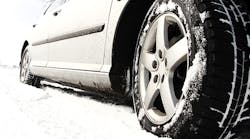Tires might arguably be the most important components on a vehicle. They’re responsible, at least partially, for making vehicles move, stop, and steer. Still, many drivers and owners take them for granted and don’t understand the basic engineering and material science that goes into them. Here’s an engineering takedown of five myths surrounding winter and all-season tires:
1. All-season tires grip wet roads better than summer tires. Designing tires is an exercise in compromises: Improving one performance factor almost always means diminishing one or more others. Engineers responsible for all-season tires sacrifice traction on wet roads for better steering in snow and in sub-freezing temperatures. They accomplish this trade-off by opting for materials that stay flexible at low temperatures, but loosen their grip on the road when it’s wet.
2. Winter tires are only for snow. The rubber compounds and other components that go into winter tires keep them flexible in temperatures below 45°F (7°C). This flexibility lets tires provide better vehicle handling and stopping, even when there is no snow but temperatures are relatively low.
3. All-season tires work fine in the winter. All-season tires are great for mild weather changes, but anyone who experiences colder winters and snow can get better performance with winter tires. Their supple rubber lets them perform in freezing temperatures without becoming brittle and cracking. Plus, their deep tread makes driving in the snow and slush and snow safer. In addition to having flexible compounds and specialized tread designs, winter tires also allow all-season tires to last longer by replacing them for a quarter to half of the year. Drivers who alternate between the two sets extend the life of both and end up spending less in the long run.
4. Winter tires are more expensive. Winter tires are cost-competitive with any other kind of tire.
5. If you have four-wheel drive, you don’t need winter tires. In the winter, four-wheel drive can help get a car or SUV going but, it won’t help when trying to stop. Four-wheel drive helps control the tires, but that doesn’t mean much if the tires themselves aren’t flexible enough or don’t have a tread designed to push snow and ice out of their way.

